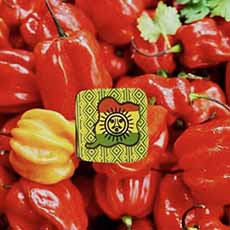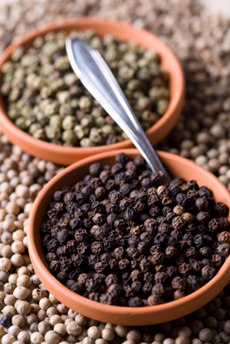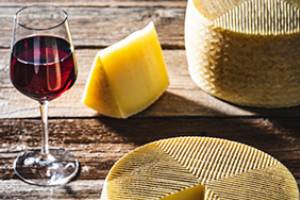M. Cacao Chile Caramels For Your Hot Valentine
|
Even if you’re not a big fan of hot chile peppers, these caramels from M. Cacao are hot stuff. Chef Delphin Gomes: Michael collaborates with Chef Delphin Gomes, a French pastry master, and Michael Nichols, the company founder, to develop chocolate creations that never fail to dazzle. For this box of spicy caramel enrobed in the finest chocolate, the chocolatiers took their chocolate covered caramels and added just enough pulverized chile pepper to provide great chile flavor without burning the tongue numb. They are still hot, we hasten to add, but chile connoisseurs can actually taste the different fruit flavors* of each type of chile. Plus, you can customize your box of caramels to the particular level of heat you want, whether all mild, medium, or hot, or a combination. We’ll get to them in a moment, but first: > The different types of chiles: a photo glossary. > The Scoville scale that establishes heat level—SHU, for Scoville Heat Units. > Below: The difference between fruits and vegetables. Before we describe each of the chiles to you, we don’t want to bury the shopping information. There are eight different types of chile caramels, and M. Cacao offers their caramels 8-piece and 16-piece boxes. You can choose a mixed box of everything, a box of the lower-heat chiles only, or a box of the high-heat chiles only. And if it all becomes too much for you, try a scoop of ice cream. The dairy is a great help in neutralizing the capsaicinoids, the chemical compounds that give chile peppers their spicy flavor and burn. > Get your chile caramels from M. Cacao here and prepare to sizzle. Note that the heat level of chiles varies depending on subspecies, terroir, and growing conditions. Mild Hatch chiles measure from 1,000–2,500 SHU, similar to Anaheim chiles. They deliver an earthy, smoky, rich flavor to the caramel (photo #3). Red Hatch chiles are the ripened version of the green chiles, with similar heat. In addition to the earthy and smoky flavors, ripeness adds a buttery quality (photo #4). Serrano Tampiqueño chiles, a variety of serrano, has medium-high heat—typically between 10,000 and 23,000 SHU. They are hotter than jalapeños but milder than Thai chiles or habaneros (photo #5). Known for their bright, fresh flavor, they have a delayed-fuse heat, allowing their flavor notes to unfold first. Scotch Bonnet chiles typically range between 100,000 and 350,000 SHUs. This places them in the same heat range as habaneros, but with a slightly sweeter and fruitier flavor (photo #6). Its complex profile including flavors of tomato and apple are appreciated by chile lovers. The bright fruity, citrus notes that are beloved in habaneros bite back with ripping heat. Habanero chiles typically range between 100,000 and 350,000 SHU (photo #7). Previously ranked as the the world’s hottest† chile pepper, these caramels are prepared in such a way that you’ll enjoy the smoky, deeply peppery notes of the chile before the slow burning heat rises up to haunt you (photo #8). Scorpion chiles are aggressively hot, with a long-lasting, lingering heat signature. The flavors you’ll experience before the heat gets you are citrusy, sweet, and even floral (photo #9). Another opportunity for “death by chocolate,” the Carolina Reaper chile caramel is a delicious way to tempt fate. Even if you like it hot, start with a small nibble from one corner (photo #10). The first chiles were brought to Spain in 1493 by Diego Álvarez Chanca, a physician on Columbus’ second voyage to the West Indies. He first wrote about their medicinal effects in 1494. From Europe, chiles spread rapidly to India, China, and Japan. In Europe, they first were grown in the monastery gardens of Spain and Portugal as botanical curiosities. The monks experimented with their culinary potential and discovered that their pungency offered an inexpensive substitute for black peppercorns, which were so costly in Europe that they were used as legal currency in some countries. “Chile pepper” is a misnomer, and the term “pepper” is not used in Latin America where chiles originated. The etymology: The first European to come across hot chiles was Christopher Columbus, when he landed in the Caribbean. He called them “pimientos” (the Spanish word for black pepper) because of their fiery similarity to black peppercorns with which he was familiar. He brought the “peppers” back to Europe and chiles have been mis-named peppers ever since. But the two aren’t related at the order and family levels of botanical classification. THE NIBBLE uses the authentic word, “chile,” and for elucidation for everyone who grew up with “pepper,” we often use “chile pepper.” But beyond peppercorns, never use “pepper,” except in the case of bell peppers, which have no heat. Why not call bells pepper, too? Because most peopled don’t realize that bell peppers, a mild vegetable, are related to hot chiles. Chiles Szechuan (Sichuan) pepper is neither pepper nor chile (photo #12). It comes from the dried husks of berries from trees in the Zanthoxylum genus of deciduous and evergreen trees, and belongs specifically to the citrus family of trees. |
|
|
|
Why chiles are considered a vegetable in cooking: In culinary terms, chiles are used like vegetables because they are savory, not sweet, and commonly cooked in savory, spicy dishes. Other botanical fruits used as vegetables include tomatoes, peppers, zucchini, and cucumbers [source: Chat GPT 2025-02-04]. CHECK OUT WHAT’S HAPPENING ON OUR HOME PAGE, THENIBBLE.COM. |
||















